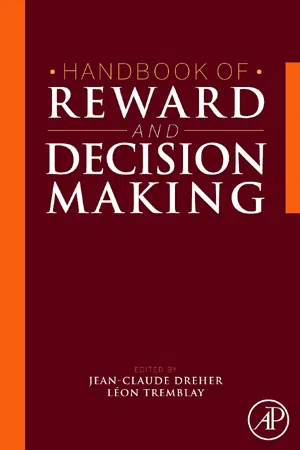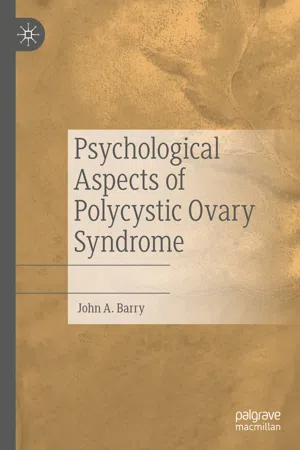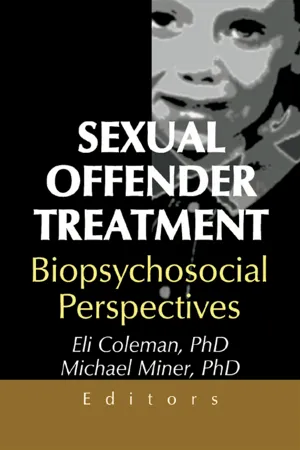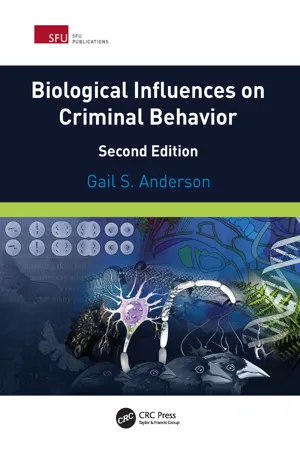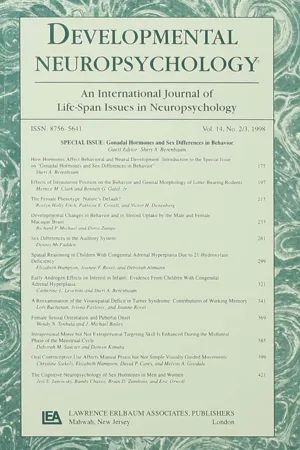Psychology
Testosterone Research
Testosterone research in psychology focuses on understanding the hormone's influence on behavior, cognition, and emotions. Studies have explored its role in aggression, dominance, risk-taking, and social interactions. Research also examines how testosterone levels may impact mood disorders, such as depression and anxiety, as well as its potential link to certain mental health conditions.
Written by Perlego with AI-assistance
Related key terms
8 Key excerpts on "Testosterone Research"
- eBook - ePub
Narcisso-Fascism
The Psychopathology of Right-Wing Extremism
- Niall McLaren(Author)
- 2023(Publication Date)
- Modern History Press(Publisher)
As a chemical, testosterone is widespread in nature, which implies that it appeared early in evolution. It is of major importance in biology, with similar substances having almost identical effects in reptiles, birds and mammals. In all species studied, testosterone is essential for normal prenatal development of the male brain. Male foetuses have high levels which persist until birth, when it drops to what are called latency levels, more or less the same as prepubertal girls. At puberty, the hormone is triggered, after which it begins to exert a wide range of effects. These include the primary sexual changes, meaning enlargement of the genitalia and onset of spermatogenesis, as well as the familiar secondary sexual characteristics. In mammals, these consist of rapid growth of muscle bulk, enlargement of the larynx, and hair growth. However, testosterone does more than produce large, bulky males who sit around gossiping in bass voices while grooming their beards. It also has profound effects on behaviour: the sexually mature male is active, exploratory, and aggressively competitive.For decades, psychiatrists and others tried to tie testosterone to mental disorders, with no luck. In the 1950s, when cheap assay techniques became available, it was hoped that unusually aggressive behaviour associated with the psychopathic (now sociopathic) personality disorder could be explained as the result of excessive testosterone; if so, an almost miraculous line of treatment would open. It didn’t happen: there is practically no relationship between male aggression, either sexual or otherwise, and resting testosterone levels. Part of the problem is that testosterone production varies so much, not just between individuals, but from hour to hour within the same subject. However, that led to another observation, which is how we manage to bring birds into the story of fascism (a more detailed treatment of this topic is available at [1], which contains full citations for this chapter).In the early 1970s, researchers studying testosterone levels in birds found some interesting results. For adult male birds in the non-breeding season, testosterone levels are low, not much different from mature females. Their plumage is dull, their behaviour quiet and they are content to spend their time foraging for food, preening and sleeping. With the onset of the breeding season, due to whatever environmental triggers are specific to the species studied, testosterone levels rise sharply and the bird’s physiology and appearance change. The gonads enlarge, spermatogenesis begins and the typical breeding plumage appears. As the season progresses, and in birds this is usually days or a few weeks at most, the hormone levels rise again and he starts to show the typical behaviour of a cock bird seeking a mate. He stakes out a territory and actively guards it against interlopers, as well as singing or other displays to attract a mate. This may involve building a nest or bower but this is all part of the same stage. His behaviour now is very different from the dull, retiring bird of the non-breeding season. He is active, highly visible, protective of his territory and his mate, and responds aggressively to competition from other males. - eBook - ePub
- Jean-Claude Dreher, Léon Tremblay(Authors)
- 2009(Publication Date)
- Academic Press(Publisher)
874 .[48]van Honk, J.; Tuiten, A.; Verbaten, R.; van den Hout, M.; Koppeschaar, H.; Thijssen, J.; de Haan, E., Correlations among salivary testosterone, mood, and selective attention to threat in humans ,.Horm. Behav. 36 (1999 ) 17 –24[49]van Honk, J.; Tuiten, A.; Hermans, E.; Putman, P.; Koppeschaar, H.; Thijssen, J.; Verbaten, R.; van Doornen, L., A single administration of testosterone induces cardiac accelerative responses to angry faces in healthy young women ,.Behav. Neurosci. 115 (2001 ) 238 –242[50]Hermans, E.J.; Ramsey, N.F.; van Honk, J., Exogenous testosterone enhances responsiveness to social threat in the neural circuitry of social aggression in humans ,.Biol. Psychiatry 63 (2008 ) 263 –270[51]Christiansen, K.; Knussmann, R., Sex hormones and cognitive functioning in men ,.Neuropsychobiology 18 (1987 ) 27 –36[52]Neave, N.; Menaged, M.; Weightman, D.R., Sex differences in cognition: the role of testosterone and sexual orientation ,.Brain Cogn. 41 (1999 ) 245 –262[53]Silverman, I.; Kastuk, D.; Choi, J.; Phillips, K., Testosterone levels and spatial ability in men ,.Psychoneuroendocrinology 24 (1999 ) 813 –822[54]Hooven, C.K.; Chabris, C.F.; Ellison, P.T.; Kosslyn, S.M., The relationship of male testosterone to components of mental rotation ,Neuropsychologia 42 (2004 ) 782 –790 - John A. Barry(Author)
- 2019(Publication Date)
- Palgrave Macmillan(Publisher)
2011 ) concluded that testosterone motivates people to engage in dominance behaviour, with the aim of achieving and maintaining social status. The behaviours are usually not physically aggressive, though they might include intimidating non-verbal communication, such as staring.One of the most interesting topics in psychology and medicine is the placebo effect. The placebo effect is when someone experiences benefits from an inert treatment that can’t be attributed to properties of the treatment. The nocebo effect is a negative version of this, where someone experiences, for example, unpleasant side effects from an inert treatment which can’t be attributed to the properties of the treatment. There is evidence that the popular misconception regarding testosterone and aggression in humans can create a nocebo effect, where people become more antisocial. A very interesting double-blind study of 60 healthy women found that those who were administered testosterone showed no more antisocial behaviour compared to women who were administered a placebo (Eisenegger et al. 2010 ). Fascinatingly, however, women who believed they had been administered testosterone showed more negative behaviours than those who believed they had received the placebo. This study demonstrates the power of false belief, and implies that people tend to have a negative conception of the effects of testosterone. It would be interesting to replicate this study in a male group to see whether the same nocebo effect occurs.Testosterone as a Prosocial Hormone
We have seen that testosterone can have some positive effects, in terms of libido and cognition. There is also a strong case for seeing testosterone as a hormone that promotes sociability. For example, in a classic study of healthy men and women, Dabbs et al. (1997- eBook - ePub
Sexual Offender Treatment
Biopsychosocial Perspectives
- Edmond J Coleman, Michael Miner(Authors)
- 2014(Publication Date)
- Routledge(Publisher)
However, below some evidence will be provided that indirectly testosterone may be linked to a greater vulnerability of men to display aggressive behavior. In an indirect way testosterone may predispose men to maladaptive stress responses.In summary, it has been impossible to relate testosterone consistently and systematically to (sexual) aggression. Testosterone has a clear effect on sexual desire and arousability (see Gijs & Gooren, 1996). Pharmacological interventions reducing the biological actions of testosterone can be expected to be helpful in those types of paraphilias characterized by intense and frequent sexual desire and sexual arousal. Some of these paraphilias may include aggression and violence and then qualify for anti-androgenic interventions (Gijs & Gooren, 1996).Anatomical and Functional Disorders of the Brain
In humans there are two well documented cases reporting aggressive behavior related to tumors in the medial hypothalamus and a number where this relation is less well established (see Alpers, 1937; Reeves & Plum, 1969). The assumption that the tumors are causally related to aggressive behavior comes from experiments in rats where lesions of the hypothalamus increase (defensive) aggressive behavior. This aggression is manifest in both intact and gonadectomized (testosterone-deprived) animals (Albert, Dyson & Walch, 1987; Albert, Pe trovic & Walch, 1989; Albert, Walch, Zalys & Dyson, 1986).Tumors in the septal area in humans are also associated with an increase of defensive aggressiveness (Zeman & King, 1958). The lesson to be learned is that when persons without a history of violence display unreasonable aggressive behavior, the possibility of a tumor in these brain areas must be considered.Aggressivity may be associated with seizure activity in the temporal lobe and maybe even specifically in the amygdala (Devinsky & Bear, 1984; Fenwick, 1991; Sano, Mayanagi, Sekino, Ogashiwa & Isjima, 1970). Two types of drugs have been shown to be beneficial: Propranolol (Sheard, 1984) and the anticonvulsant Carbamazepine (Sheard, 1984; Mattes, 1990). - eBook - ePub
Essentials of Social Psychology
An Indian Perspective
- Shubhra Mangal, Shashi Mangal(Authors)
- 2022(Publication Date)
- Routledge(Publisher)
According to this theory, aggression in individuals is resulted through the imbalances caused in the secretion of hormones by their endocrine glands. One of such suspected big hormonal culprits in males is testosterone, the male sex hormone (which is 10 times higher in males than females). Commenting on the nature and role of testosterone, in causing aggression among humans, Widmeyer et al. (2002:354) write:Testosterone is a male steroid hormone that rises sharply when boys hit puberty. Seen apparently as a body energizer, its increased level has been linked with the tendency to aggress, fighting and violence. A number of athletes are often found to take the heavy doses of this steroid for the maximization of their arousal level and excitement in the competitive sport acts. The doses can be taken in the form of testosterone gels, patches, pellets and injections.Hormonal Theory of AggressionA theory of aggression asserting that aggression in individuals is resulted through the imbalances caused in the secretion of hormones by their endocrine glands.However, research work carried out for establishing a relationship between endogenous testosterone levels and aggressive behavior has concluded in negative by asserting that the relationship is not consistent. The doses of testosterone taken by athletes may help them as a good body energizer and arousal agent but it cannot be said that it definitely will lead them to aggression. It may cause certain individuals to be aggressive, but for them also, it is difficult to explain why they are aggressive in some situations and not in others. Moreover, it also becomes harder to explain why the athletes possessing little or lower level of testosterone, for example, female athletes, can be aggressive. In this way, the hormonal imbalances cannot be said to be the necessary and substantial cause for the aggressive or violent behavior of the athletes.Psycho-Analytical Instinct Theory of Aggression
As the main propagator of this theory of aggression, we can name the famous psychologist Sigmund Freud (1925, 1950). Let us examine his views in this regard. - eBook - ePub
- Gail Anderson(Author)
- 2019(Publication Date)
- CRC Press(Publisher)
Steroids 61: 374–378.31 . Carré, J.M. and Olmstead, N.A. 2015. Social neuroendocrinology of human aggression: Examining the role of competition-induced testosterone dynamics. Neuroscience 286: 171–186.32 . Carré, J.M. and Archer, J. 2018. Testosterone and human behavior: The role of individual and contextual variables. Curr. Opin. Psychol. 19: 149–153.33 . Carré, J.M., Geniole, S.N., Ortiz, T.L., Bird, B.M., Videto, A., and Bonin, P.L. 2017. Exogenous testosterone rapidly increases aggressive behavior in dominant and impulsive men. Biol. Psychiatry 82(4): 249–256.34 . Dabbs, J.M. and Morris, R. 1990. Testosterone, social class and antisocial behavior in a sample of 4,462 men. Psychol. Sci. 1: 209–211.35 . Dabbs, J.M., Frady, R.L., Carr, T.S., and Besch, N.F. 1987. Saliva testosterone and criminal violence in young adult prison inmates. Psychosomatic Med. 49: 174–182.36 . Dabbs, J.M., Ruback, G.J., Frady, R.L., Hopper, C.H., and Sgoutas, D.S. 1988. Saliva testosterone and criminal violence among women. Person. Individ. Diff. 9: 269–275.37 . Dabbs, J.M. and Hargrove, M.F. 1997. Age, testosterone and behavior among female prison inmates. Psychosomatic Med. 59(5): 477–480.38 . Dabbs, J.M., Carr, T.S., Frady, R.L., and Riad, J.K. 1995. Testosterone, crime and misbehavior among 692 male prison inmates. Person. Individ. Diff. 18(5): 627–633.39 . Dabbs, J.M., Riad, J.K., and Chance, S.E. 2001. Testosterone and ruthless homicide. Person. Individ. Diff. 31: 599–603.40 . Wong, J.S. and Gravel, J. 2018. Do sex offenders have higher levels of testosterone? Results from a meta-analysis. Sex Abuse 30(2): 147–168.41 . Kingston, D.A., Seto, M.C., Ahmed, A.G., Fedoroff, P., Firestone, P., and Bradford, J.M. 2012. The role of central and peripheral hormones in sexual and violent recidivism in sex offenders. J. Am. Acad. Psychiatry Law - eBook - ePub
Gonadal Hormones and Sex Differences in Behavior
A Special Issue of developmental Neuropsychology
- Sheri A. Berenbaum, Sheri A. Berenbaum(Authors)
- 2014(Publication Date)
- Psychology Press(Publisher)
As the articles in this special issue demonstrate, gonadal hormones have powerful effects on the development of the brain and behavior in human beings, as in other species. Both androgens and estrogens affect behavior throughout development, from early prenatal life through adulthood, as demonstrated in studies with a variety of methods in several species. High levels of testosterone and other androgens that are present early in development are shown to facilitate the development of male-typical characteristics, and to inhibit the development of female-typical characteristics. Some of these effects are suggested to be mediated by the conversion of androgen to estradiol in the brain. Ovarian hormones are also shown to play an important role in the development and maintenance of female-typical characteristics, and their effects on the brain appear to extend beyond the prenatal and early postnatal periods. Nevertheless, there are not simple relations between the amount of hormone present and behavior. Behavioral effects of hormones are not uniform across behaviors or across individuals. Variations have been shown to relate to the timing of exposure, the organism’s sensitivity to the hormones, the specific hormone involved, and modification by the physical and social environment, although not all factors have been studied in all species, and many have not been studied directly in people. The articles in this special issue also describe attempts to identify the mechanisms—neural and basic behavioral—that mediate hormonal effects on complex human behaviors.The articles in this special issue testify to the breadth and vitality of research into the ways that hormones affect the development of sex-typical behavior and illustrate several important themes that have emerged in human psychoneuroendocrinology. First, it is now clear that hormones do affect human behavior, and the important questions relate to the mechanisms and details of hormone action. Second, there are many ways to study hormone effects on human behavior, and the articles in this issue describe these methods and their products. Third, traditional conceptions of hormone-behavior relations have generally stood the test of time, but recent developments have begun to reveal the complexity of these relations.Renewed interest in hormonal influences on human behavior among neuropsychologists was stimulated by Geschwind and Galaburda’s (1985) proposals regarding the role of testosterone on brain development and the immune system. There has been an extraordinary amount of work testing their hypotheses regarding associations among left-handedness, learning disabilities, and immune dysfunction. Most studies have failed to support those hypotheses (see Bryden, McManus, & Bulman-Fleming, 1994, and McManus & Bryden, 1991, for a review and thoughtful discussion of the topic). - eBook - ePub
Out on a Limb
Selected Writing, 1989–2021
- Andrew Sullivan(Author)
- 2021(Publication Date)
- Avid Reader Press / Simon & Schuster(Publisher)
Unlike Popeye’s spinach, however, testosterone is also, in humans at least, a relatively subtle agent. It is not some kind of on-off switch by which men are constantly turned on and women off. For one thing, we all start out with different baseline levels. Some women may have remarkably high genetic T levels, some men remarkably low, although the male-female differential is so great that no single woman’s T level can exceed any single man’s, unless she, or he, has some kind of significant hormonal imbalance. For another, and this is where the social and political ramifications get complicated, testosterone is highly susceptible to environment. T levels can rise and fall depending on external circumstances—short term and long term. Testosterone is usually elevated in response to confrontational situations—a street fight, a marital spat, a presidential debate—or in highly charged sexual environments, like a strip bar or a pornographic web site. It can also be raised permanently in continuously combative environments, like war, although it can also be suddenly lowered by stress.Because testosterone levels can be measured in saliva as well as in blood, researchers like Alan Booth, Allan Mazur, J. Richard Udry, and particularly James M. Dabbs, whose book Heroes, Rogues and Lovers will be out this fall, have compiled quite a database on these variations. A certain amount of caution is advisable in interpreting the results of these studies. There is some doubt about the validity of onetime samples to gauge underlying testosterone levels. And most of the studies of the psychological effects of testosterone take place in culturally saturated environments, so that the difference between cause and effect is often extremely hard to disentangle. Nevertheless, the sheer number and scale of the studies, especially in the last decade or so, and the strong behavioral correlations with high testosterone, suggest some conclusions about the social importance of testosterone that are increasingly hard to gainsay.Testosterone is clearly correlated in both men and women with psychological dominance, confident physicality, and high self-esteem. In most combative, competitive environments, especially physical ones, the person with the most T wins. Put any two men in a room together and the one with more testosterone will tend to dominate the interaction. Working women have higher levels of testosterone than women who stay at home, and the daughters of working women have higher levels of testosterone than the daughters of housewives. A 1996 study found that in lesbian couples in which one partner assumes the male, or “butch,” role and another assumes the female, or “femme,” role, the “butch” woman has higher levels of testosterone than the “femme” woman. In naval medical tests, midshipmen have been shown to have higher average levels of testosterone than plebes. Actors tend to have more testosterone than ministers, according to a 1990 study. Among seven hundred male prison inmates in a 1995 study, those with the highest T levels tended to be those most likely to be in trouble with the prison authorities and to engage in unprovoked violence. This is true among women as well as among men, according to a 1997 study of eighty-seven female inmates in a maximum-security prison. Although high testosterone levels often correlate with dominance in interpersonal relationships, it does not guarantee more social power. Testosterone levels are higher among blue-collar workers, for example, than among white-collar workers, according to a study of more than four thousand former military personnel conducted in 1992. A 1998 study found that trial lawyers—with their habituation to combat, conflict, and swagger—have higher levels of T than other lawyers.
Index pages curate the most relevant extracts from our library of academic textbooks. They’ve been created using an in-house natural language model (NLM), each adding context and meaning to key research topics.

